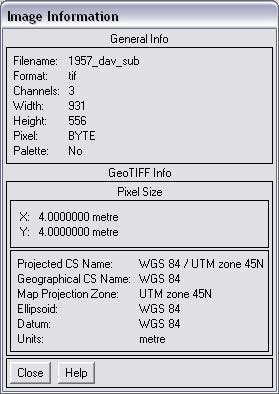
Development of glacial lakes in the Khumbu Himal - Part 2


This exercise is divided into three parts and requires the use of LEOWorks.
Extension of glacial lakes
We will now calculate the change in the extension of the glacial lakes. In the GIS tool for image <…>, choose 'information'. By clicking on a Polygon, the Theme Information will show you several different kinds of information for the specific polygon:
number of points, perimeter, and area. Unfortunately, the area and perimeter appear only in the pixel unit.
Write down the number of pixel (area) for each polygon in each shapefile and sum them up in the end. In fact, we have done this with the file named 'Imja_1957n.shp', and we have also introduced these numbers in two different Attributes: an Attribute called 'Perimeter', and another one called 'Surface'. To do this for the other years, use Edit>Theme Tool. Click Tool>New Attribute, enter the name (Surface), Integer, OK. Now you can fill, for each polygon (there might be only one), the corresponding number of pixels. Always hit the 'return' key after each entry.
Clicking on the 'i' in the Image Viewer window will show us the Image Information of this image. We can read that the pixel size is 4.00 metres in both X and Y directions.
For this reason, the total sum of the area has to be multiplied by 16 (4*4) square metres, which is the total area for each date.
 |
Image Information
|
Summary: On the GIS Tool window, Open Edit>Theme Tool and study the Attributes. Clicking on 'Surface', the statistics will be shown, also including the Sum of all the surfaces (number of pixels, hence notyet the surface in square metres). If you have not generated the Attribute, click Tools > Information, and click on Polygon 1 and read the 'Area'.
To achieve the total area of all the glacial lakes for one date, you have to sum up the area(s) of each polygon and multiply the result by 16.
Last update: 16 April 2013

 |  | 
Monitoring of glaciers in the Himalayas

| | • | Introduction (http://www.esa.int/SPECIALS/Eduspace_Global_EN/SEM3TN0SAKF_0.html) |  | | • | Glaciers (http://www.esa.int/SPECIALS/Eduspace_Global_EN/SEM93O0SAKF_0.html) |  | | • | Investigation area (http://www.esa.int/SPECIALS/Eduspace_Global_EN/SEM69O0SAKF_0.html) |  | | • | Khumbu's glaciers (http://www.esa.int/SPECIALS/Eduspace_Global_EN/SEMJFO0SAKF_0.html) |  | | • | Imja glacier (http://www.esa.int/SPECIALS/Eduspace_Global_EN/SEMCHO0SAKF_0.html) |  | 
Exercises

| | • | Location of the study area, Khumbu Himal (http://www.esa.int/SPECIALS/Eduspace_Global_EN/SEM3SO0SAKF_0.html) |  | | • | Development of glacial lakes in the Khumbu Himal (http://www.esa.int/SPECIALS/Eduspace_Global_EN/SEM1AP0SAKF_0.html) |  | | • | Glacier retreat at Honku glacier (http://www.esa.int/SPECIALS/Eduspace_Global_EN/SEM2EP0SAKF_0.html) |  | 
Links

| | • | Further Reading (http://www.esa.int/SPECIALS/Eduspace_Global_EN/SEM9HP0SAKF_0.html) |  | 
Eduspace - Software

| | • | LEOWorks 3 (http://esamultimedia.esa.int/multimedia/LEOWorks3.exe) |  | 
Eduspace - Download

| | • | glacier_worksheet1.zip (http://esamultimedia.esa.int/docs/eduspace/glacier_worksheet1.zip) |  | | • | glacier_worksheet2.zip (http://esamultimedia.esa.int/docs/eduspace/glacier_worksheet2.zip) |  | | • | glacier_worksheet3.zip (http://esamultimedia.esa.int/docs/eduspace/glacier_worksheet3.zip) |  |

|

